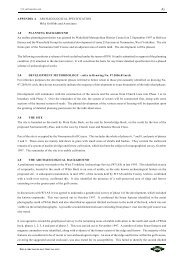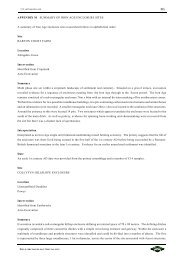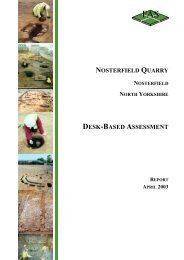ARCHAEOLOGICAL EVALUATION - Mike Griffiths and Associates
ARCHAEOLOGICAL EVALUATION - Mike Griffiths and Associates
ARCHAEOLOGICAL EVALUATION - Mike Griffiths and Associates
You also want an ePaper? Increase the reach of your titles
YUMPU automatically turns print PDFs into web optimized ePapers that Google loves.
FAS_lbf01.wpd 16<br />
a detailed consideration of the North Yorkshire Sites <strong>and</strong> Monuments Records, which were subsequently<br />
databased <strong>and</strong> mapped to allow for discussion of the development of the l<strong>and</strong>scape.<br />
Cropmarks <strong>and</strong> Historic Field Boundaries<br />
During the desk-based assessment of the surrounding area (FAS 2003), a comprehensive study of all available<br />
aerial photographs was undertaken, <strong>and</strong> visible cropmarks plotted using AutoCad. Further field boundaries were<br />
identified from Ordnance Survey maps, <strong>and</strong> from a number of enclosure maps held at North Yorkshire County<br />
Record Office, allowing a map of historic field boundaries in the area to be reconstructed (Figure 5).<br />
The area surrounding Ladybridge Farm formed part of Thornborough Common prior to 1799, when enclosure<br />
maps record the area to be enclosed. These areas would presumably have been used as common l<strong>and</strong> for local<br />
settlements, providing pasture <strong>and</strong> resources. After 1799, the common l<strong>and</strong> was divided <strong>and</strong> allocated to various<br />
l<strong>and</strong>holders; large tracts of l<strong>and</strong> were given over to the Earl of Ailesbury. Judging by the lists of field names<br />
<strong>and</strong> their l<strong>and</strong> use in 1838, it seems that much of the l<strong>and</strong> was given over to arable farming, with some pasture<br />
<strong>and</strong> meadow, <strong>and</strong> more limited areas recorded as woodl<strong>and</strong>.<br />
The mapped field boundaries on the Ladybridge Farm site suggest that the southern part of the site was enclosed<br />
into a series of rectilinear fields aligned north-south along Thornfield Road; the northern part of the site was<br />
divided east-west. Boundaries shown on the later Ordnance survey maps show these fields to have been further<br />
subdivided, to form a more irregular pattern of division. Many of these boundaries have since been removed,<br />
as farming methods have changed.<br />
A series of linear <strong>and</strong> curvilinear features were identified as cropmarks, most of which are visible on a<br />
photograph held by the National Monuments Record (MAL 71178, November 1971, ©NYCC) (Figure 6).<br />
These features included a series of three, concentric, sub-oval features to the west of Ladybridge Farm which<br />
were considered to be geological in origin. A large curvilinear cropmark in the northwestern corner of the main<br />
area of investigation, <strong>and</strong> a further curvilinear feature in the northern part of the area were considered to be of<br />
archaeological interest, although it was recognised that they may simply reflect local topography. The remaining<br />
cropmarks were also potentially archaeological, particularly the very ephemeral circular <strong>and</strong> curvilinear features<br />
in the centre of the area of investigation; however, the possibility that these features reflected geological<br />
variation or l<strong>and</strong> drainage had not been discounted.<br />
2.9.4 Palaeoenvironment<br />
The nature of the geology <strong>and</strong> sediments in the Nosterfield area are such that a number of palaeoenvironmental<br />
studies have been carried out, most notably concentrating on the peat which had accumulated in a relict lake in<br />
the north of the Nosterfield Quarry site, <strong>and</strong> also on sediments within a number of sink holes which have formed<br />
in the area, caused by the collapse of surface strata due the dissolution of the underlying gypsum deposits.<br />
Work on peat sediments from the Nosterfield area has been used to discuss the past vegetation <strong>and</strong> topography<br />
of the locality, <strong>and</strong> environmental change. During the earliest phases of investigation at Nosterfield, a 1.0m<br />
monolith was extracted from the area of the Flasks, which identified phragmites peat, formed in the edge of the<br />
ancient lake (Berg 1991; FAS 2005: Investigation 1). More recently, a radiocarbon date has been acquired at<br />
FIELD ARCHAEOLOGY SPECIALISTS







